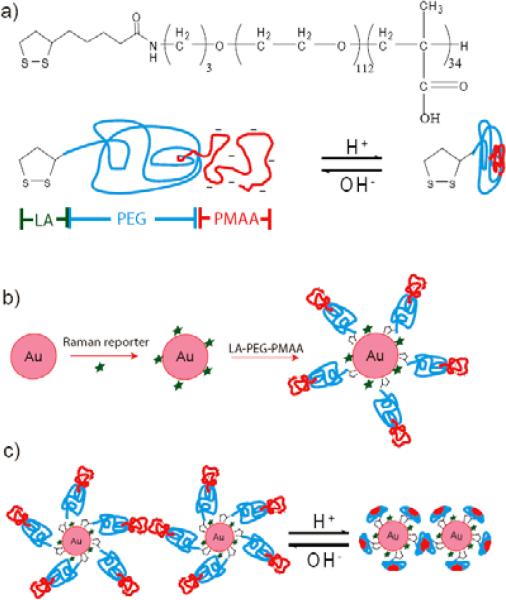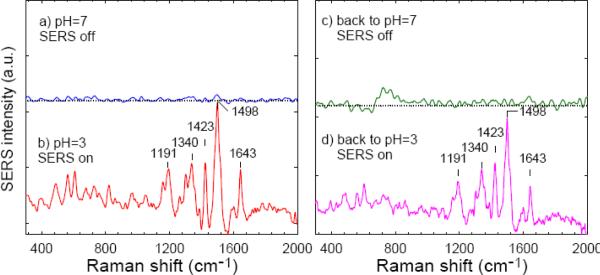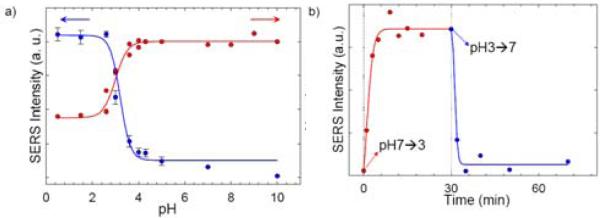Small particles on the nanometer scale are of considerable current interest in chemistry, biology, and medicine due to their size-dependent electronic and optical properties and also their dimensional similarities with biomacromolecules (e.g., proteins and nucleic acids).1 Colloidal gold nanocrystals are considered to be “plasmonic nanoruler” because they contain free electrons that can be collectively and resonantly excited at optical frequencies, leading to large enhancement of the electromagnetic field near the particle surface.2 Recent work has shown that nanoscale junctions or nanogaps between two or more particles are associated with plasmonic “hot spots”,3-5 and that surface-enhanced Raman scattering (SERS) increases by two orders of magnitude when the gap distance is reduced from 35 nm to 10 nm.6 Plasmonic nanoparticles have also find uses in super-resolution optical imaging7,8 and tip-enhanced Raman scattering (TERS),9 and sequence-specific DNA detection.10,11
Here we report the development of stimuli-responsive SERS nanoparticles in which plasmonic coupling and electromagnetic field enhancement are controlled by molecular conformation changes. The experimental design involves the use of colloidal gold nanocrystals and thiolated block copolymers consisting of a pH-responsive ploymethacrylic acid (PMAA) block, an amphiphilic polyethylene glycol (PEG) block, and a terminal lipoic acid anchoring group. Stimuli-responsive polymers exhibit reversible conformational changes in response to environmental factors such as pH, temperature, organic molecules, and metal ions.12 The basic principle is that large structural changes such as conformation swelling and collapsing can reversibly alter the steric hindrance, solubility, or light scattering properties of molecular conjugates. Recent work has linked thermo-responsive polymers to colloidal nanoparticles, and has shown that the resulting nanoconjugates are stable and are responsive to temperature.13,14 In addition, poly-(N-isopropylacrylamide (pNIPAM) is found to trap analyte molecules near the surface of gold nanoparticles, leading to increase SERS signals.15 This increase is achieved with single particles, and does not take advantage of plasmonic coupling between adjacent nanoparticles.
As shown in Figure 1, the stimuli-responsive polymer has a random-coil expanded conformation above pH 4 because the carboxylic acid groups are ionized and the PMAA segment is hydrophilic under such conditions. At more acidic pH's (pH < 3), the PMAA segment becomes nearly neutral and slightly hydrophobic, and changes to a condensed (collapsed) conformation. Meanwhile, the PEG layer is neutral and amphiphilic (soluble in both polar and nonpolar solvents), and can intermix with the neutralized methacrylic acid groups, further condensing the overall copolymer structure in solution. When gold nanocrystals are coated with a layer of this copolymer, strong steric and electrostatic forces prevent the particles from contacting each other at pH > 4. When the pH is lowered to 3, however, large conformational changes pull and condense adjacent particles into small clusters (Figure 1c). This conformational transition is indicated by dynamic light scattering (DLS) measurement showing that the hydrodynamic size of the polymer-coated particles decreases from 85 nm at pH 7 to 65 nm at pH 3 (see Supporting Figure S1).
Figure 1.
Schematic diagrams showing the structure, preparation, and pH-responsive behavior of smart SERS nanoparticles. (a) Molecular structure of pH-induced conformational changes of a thiolated block copolymer consisting of a pH-responsive ploymethacrylic acid (PMAA) block (MW 3000), an amphiphilic polyethylene glycol (PEG) block (MW 5000), and a terminal lipoic acid (LA) anchoring group. (b) Preparation of dye-encoded gold nanoparticle with SERS and stimuli-responsive properties. (c) Nanoparticle aggregation induced by polymer conformational changes, leading to plasmonic coupling and SERS. Each gold particle (60 nm) was tagged with ∼1,000 reporter molecules (such as organic dyes) and was encapsulated with ∼104 LA-PEG-PMAA copolymer molecules.
Transmission electron microscopy (TEM) shows the pH-induced nanoaggregates are mainly dimers, trimers, and small clusters, depending on the nanoparticle concentration and incubation times after the pH change (Supporting Figure S2). The nanoaggregates contain closely packed particles with separation distances as small as 4−6 nm, in agreement with the number-weighted DLS size data at pH 3. Considering that a PEG (5K) layer increases the hydrodynamic diameter of gold particles by 15−20 nm,16 it is surprising that the PEG-PMAA copolymer would give rise to such small distances between particles in its collapsed state. A likely explanation is that PEG and PMAA do not exist as separate domains, but are structurally intermingled through hydrogen bonding and hydrophobic interactions (see Figure 1a). Similar structural changes are also observed from PEG-NIPAM copolymers, which are responsive to temperature (data not shown). Indeed, neutral and weakly hydrophobic ligands have been found to fold back and become buried in an amphiphilic PEG layer on the surface of stealth liposomes.17
Figure 2 depicts the SERS signals of a reporter molecule (a quencher dye called QSY) in response to pH. At neutral pH, the gold nanoparticles show a well-defined surface plasmon resonance peak at 535 nm (Supporting Figure S3), but no detectable SERS signals. At pH 3, the SERS spectrum is turned on by strong plasmonic coupling and electromagnetic enhancement modulated by the gap distance between gold nanoparticles. This coupling also results in significant broadening and red shifting of the absorption spectrum. The SERS spectrum can be completely “switched off” by changing the pH back to 7. In contrast, the absorption spectrum is less responsive and cannot be completely switched back (Supporting Figure S3). The SERS intensity ratios between the on and off states are about 30−35 under our experimental conditions (see Supporting Figure S4), whereas the absorbance (measured at 535 nm) changes only by a factor of 2. The observed conformational response is also strongly dependent on the density of polymer molecules on the particle surface, in agreement with previous work of Minko.18 Gold particles with intermediate polymer densities (controlled by the kinetics of polymer adsorption) are most responsive, yielding the highest on/off intensity ratios. This finding could be explained by two factors: (1) PEG steric shielding helps to minimize particle aggregation and reduce background SERS signals; and (2) the adsorbed copolymers are able to adopt different conformations (from fully extended to fully collapsed) at different pH's. At low densities, the copolymers take on a “pancake-shaped” conformation and form a thin layer, which is much less effective in stabilizing the gold particles or in condensing adjacent particles. As a result, the SERS intensities are different only by a factor of 1.5 between pH 3 and 7 at low polymer densities (see Supporting Figure S5).
Figure 2.
SERS spectra of stimuli-responsive gold nanoparticles obtained at (a) pH 7, (b) pH changed to 3, (c) pH changed back to 7, and (d) pH changed back to 3. SERS spectra were recorded on a compact Raman system using 785 nm (20 mW) laser excitation. Data acquisition time = 1 second.
Quantitative studies reveal that both SERS and UV-Vis signal changes take place in a narrow pH range of 2 − 4 (Figure 3a). A major difference is that the magnitude of intensity changes is much larger for SERS (high/low ratio = 20) than for UV-Vis absorbance (high/low ratio = 2). When the pH is cycled between 7 and 3, the kinetics of SERS responses is similarly fast for on/off switching, with characteristic half-times of 3 minutes (see Figure 3b). This response behavior suggests that maximal SERS intensities are obtained with nanoparticle dimers, trimers, and small clusters (see Supporting Figure S2), and do not require the formation of large aggregates. This finding is consistent with the work of Van Duyne and coworkers, who have found that small nanoaggregates consisting of only 2−3 particles can be “hot” for single-molecule SERS.5
Figure 3.
(a) Plots of SERS intensity and UV-Vis absorbance as a function of pH, and (b) on/off kinetics of SERS signal changes between pH 7 and 3. The data were obtained by monitoring the SERS signal intensity at 1498 cm−1 and the optical absorbance at 535 nm.
In summary, we have developed thiolated block copolymers consisting of a pH-responsive PMAA segment and an amphiphilic PEG segment for encapsulating gold nanocrystals. The results demonstrate that SERS signals can be switched on and off by molecular conformational changes. An important finding is that neutralized PMAA molecules are able to interact with amphiphilic PEG chains, leading to highly compact and intermingled copolymer structures on the surface of nanoparticles. This type of molecular conformation changes provides a new strategy for controlling the distances and plasmonic interactions between two or more gold nanoparticles. This work opens the possibility of using SERS nanoparticle tags for biomolecular binding and enzymatic cleavage studies.19
Supplementary Material
Acknowledgement
This work was supported by grants from the National Institutes of Health (P20 GM072069, R01 CA108468, and U01HL080711, U54CA119338). J.L. acknowledges Hunan University for financial support. S.N. is a Distinguished Cancer Scholar of the Georgia Cancer Coalition (GCC).
Footnotes
Supporting Information Available: Materials, Procedures, and Supporting Figures S1-S5. This information is available free of charge via the Internet at http://pubs.acs.org.
References
- 1.a Henglein A. Chem. Rev. 1989;89:1861. [Google Scholar]; b Schmid G. Chem. Rev. 1992;92:1709. [Google Scholar]; c Niemeyer CM. Angew. Chem., Int. Ed. 2001;40:4128. doi: 10.1002/1521-3773(20011119)40:22<4128::AID-ANIE4128>3.0.CO;2-S. [DOI] [PubMed] [Google Scholar]
- 2.a Camden JP, Dieringer JA, Zhao J, Van Duyne RP. Acc. Chem. Res. 2008;41:1653–1661. doi: 10.1021/ar800041s. [DOI] [PubMed] [Google Scholar]; b Anker JN, Hall WP, Lyandres O, Shah NC, Zhao J, Van Duyne RP. Nat. Mater. 2008;7:442–453. doi: 10.1038/nmat2162. [DOI] [PubMed] [Google Scholar]
- 3.Blackie E, Le Ru EC, Meyer M, Timmer M, Burkett B, Northcote P, Etchegoin PG. Phys. Chem. Chem. Phys. 2008;10:14147–14153. doi: 10.1039/b803738h. [DOI] [PubMed] [Google Scholar]
- 4.Michaels AM, Nirmal M, Brus LE. J. Am. Chem. Soc. 1999;121:9932–9939. [Google Scholar]
- 5.Camden JP, Dieringer JA, Wang Y, Masaiello DJ, Marks LD, Schatz GC, Van Duyne RP. J. Am. Chem. Soc. 2008;130:12616–12617. doi: 10.1021/ja8051427. [DOI] [PubMed] [Google Scholar]
- 6.Lee SJ, Guan Z, Xu H, Moskovits M. J. Phys. Chem. C. 2007;111:17985. [Google Scholar]
- 7.a Fang N, Lee H, Sun C, Zhang X. Science. 2005;308:534–537. doi: 10.1126/science.1108759. [DOI] [PubMed] [Google Scholar]; b Ebbesen TW, Lezec HJ, Ghaemi HF, Thio T, Wolff PA. Nature. 1998;391:667–669. [Google Scholar]
- 8.a Sonnichsen C, Reinhardt BM, Liphardt J, Alivisatos AP. Nature Biotechnol. 2005;23:741–745. doi: 10.1038/nbt1100. [DOI] [PubMed] [Google Scholar]; b Liu GL, Yin YD, Kunchakarra S, Mukherjee B, Gerion D, Jett SD, Bear DG, Gray JW, Alivisatos AP, Lee LP, Chen FQF. Nat. Nanotechnol. 2006;1:47–52. doi: 10.1038/nnano.2006.51. [DOI] [PubMed] [Google Scholar]
- 9.Bailo E, Deckert V. Chem. Soc. Rev. 2008;37:921–930. doi: 10.1039/b705967c. [DOI] [PubMed] [Google Scholar]
- 10.Graham D, Thimpson DG, Smith WE, Faulds K. Nat. Nanotechnol. 2008;3:548–551. doi: 10.1038/nnano.2008.189. [DOI] [PubMed] [Google Scholar]
- 11.Qian XM, Zhou X, Nie SM. J. Am. Chem. Soc. 2008;130:14934–14935. doi: 10.1021/ja8062502. [DOI] [PMC free article] [PubMed] [Google Scholar]
- 12.a Hoffman AS, Stayton PS. Prog. Polym. Sci. 2007;32:922–932. [Google Scholar]; b Stayton PS, Shimoboji T, Long C, Chilkoti A, Chen G, Harris JM, Hoffman AS. Nature. 1995;378:472–474. doi: 10.1038/378472a0. [DOI] [PubMed] [Google Scholar]; c Holtz JH, Asher SA. Nature. 1997;389:829–832. doi: 10.1038/39834. [DOI] [PubMed] [Google Scholar]
- 13.Zhu MQ, Wang LQ, Exarhos GJ, Li ADQ. J. Am. Chem. Soc. 2004;126:2656–2657. doi: 10.1021/ja038544z. [DOI] [PubMed] [Google Scholar]
- 14.Shen Y, Kuang M, Shen Z, Nieberle J, Duan HW, Frey H. Angew. Chem. Int. Ed. 2008;47:2227–2230. doi: 10.1002/anie.200704572. [DOI] [PubMed] [Google Scholar]
- 15.Alvarez-Puebla RA, Contreras-Caceres R, Pastoriza-Santos I, Perez-Juste J, Liz-Marzan LM. Angew. Chem. Int. Ed. 2009;48:138–143. doi: 10.1002/anie.200804059. [DOI] [PubMed] [Google Scholar]
- 16.Qian XM, Peng XH, Ansari DO, Yin-Goen Q, Chen GZ, Shin DM, Yang L, Young AN, Wang MD, Nie SM. Nat. Biotechnol. 2008;26:83–90. doi: 10.1038/nbt1377. [DOI] [PubMed] [Google Scholar]
- 17.Sawant RR, Sawant RA, Kale AA, Torchilin VP. J. Drug Targeting. 2008;16:596–600. doi: 10.1080/10611860802230240. [DOI] [PMC free article] [PubMed] [Google Scholar]
- 18.Minko S. J. Macromolec. Sci. Part C: Polymer Rev. 2006;46:397. [Google Scholar]
- 19.Reinhard BM, Sheikholeslami S, Mastroianna A, Alivisatos AP, Liphardt J. Proc. Natl. Acad. Sci. USA. 2007;104:2667–1672. doi: 10.1073/pnas.0607826104. [DOI] [PMC free article] [PubMed] [Google Scholar]
Associated Data
This section collects any data citations, data availability statements, or supplementary materials included in this article.





